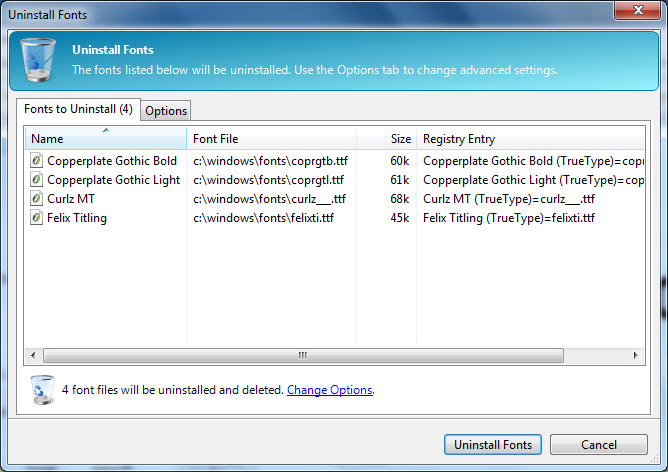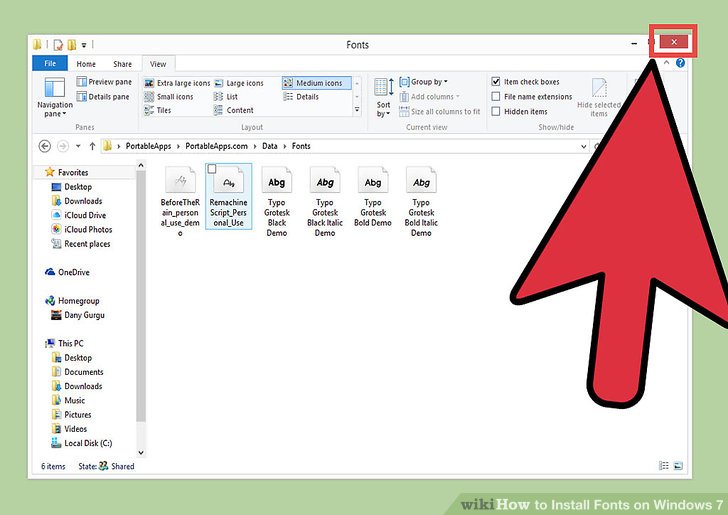

Also, you can increase or decrease the font size. The font style can be set to normal, italic or oblique. Customize the font color, style and sizeĪs far as colors are concerned, you can either pick one of the preset standard colors provided by the font utility, such as aquamarine, beige and blue violet, or set up a custom color by adjusting the red, green and blue channels. You can explore scroll this list, view font names and how sample text looks like in each font style, as well as replace the default text with anything else you want. Packed in a Modern UI, Font Viewer has an elegant, light grey background and shows the installed fonts right at startup.
Font viewer win7 windows#
The font tool can be downloaded and installed only from the Windows Store. View installed fonts and write sample text Before proceeding any further, you should know that it doesn't implement options for installing and uninstalling fonts, so it's not a font manager. It's useful for identifying fonts suitable for creating wedding invitations, birthday cards, and other important events. Find the perfect fonts for special occasions, like wedding invitations or birthday cards
Font viewer win7 install#
On top of the frustration that users have to feel, I think this is a very bad publicity for freelance type designers, because the font actually is not corrupt, yet the user can't install it and obviously you can't explain to them that it's a Windows GDI thing, because they paid for a font and they want to use it anyhow.Font Viewer is a Metro-style application you can use to view all fonts installed on your computer, explore various styles and write sample text to see how it looks like, as well as customize font colors.
Font viewer win7 windows 10#
I only have one question though: Since the only reason is GDI rejection, how come a single font file opens on a PC with Windows 10 and yet the same font can't be installed on another system with Windows 10? Logically it must not occur.Īs I mentioned before you got different results from people with the same Windows version. For a kernel component like GDI, it is not a bad idea. To be clear: Windows Font Viewer rejects a font only when GDI rejects it.Ĭurrent GDI error handler only rejects a font but not reports the reason. Obviously I couldn't make it clear enough. My point from the beginning was to find out what's the issue with Windows Font Viewer. about this error, so again I don't think it is a font-related problem. Thanks, I will keep this in mind and do that for sure, but yet again it's not about my font or my experience solely, when you search "not a valid font in Windows" you get 122,000,000 results.

You can try to run your font through OTS first and see whether OTS throws an error. I hope I was clear To get the real reason that why GDI rejects a font you need kernel debugging. What I - was - am looking for is to find out how Windows Font Viewer does this "recognition" which ends to this error.

The reason I'm saying is not font-related because it happens to very very well-known fonts which millions of people already installed them, and the reason I'm saying it's not going away because it's connected to how Windows identifies fonts, and you won't see it on other operating systems (as far as I know). (The same file would have not any problem with another font installer on the same PC) It's something - maybe a bug - or a built-in thing in Windows which "recognize" a file as a font and if it determines the file is not "valid", then Windows Font Viewer would not open the font. If it’s not something that would go away “with anything a user would do”, but it’s also “not a font-related problem” - then, I’m not sure what you’re hoping for.


 0 kommentar(er)
0 kommentar(er)
